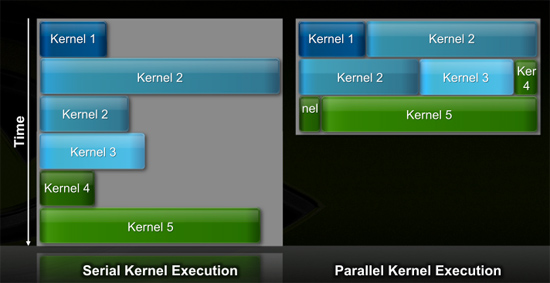NVIDIA's Fermi: Architected for Tesla, 3 Billion Transistors in 2010
by Anand Lal Shimpi on September 30, 2009 12:00 AM EST- Posted in
- GPUs
Efficiency Gets Another Boon: Parallel Kernel Support
In GPU programming, a kernel is the function or small program running across the GPU hardware. Kernels are parallel in nature and perform the same task(s) on a very large dataset.
Typically, companies like NVIDIA don't disclose their hardware limitations until a developer bumps into one of them. In GT200/G80, the entire chip could only be working on one kernel at a time.
When dealing with graphics this isn't usually a problem. There are millions of pixels to render. The problem is wider than the machine. But as you start to do more general purpose computing, not all kernels are going to be wide enough to fill the entire machine. If a single kernel couldn't fill every SM with threads/instructions, then those SMs just went idle. That's bad.

GT200 (left) vs. Fermi (right)
Fermi, once again, fixes this. Fermi's global dispatch logic can now issue multiple kernels in parallel to the entire system. At more than twice the size of GT200, the likelihood of idle SMs went up tremendously. NVIDIA needs to be able to dispatch multiple kernels in parallel to keep Fermi fed.
Application switch time (moving between GPU and CUDA mode) is also much faster on Fermi. NVIDIA says the transition is now 10x faster than GT200, and fast enough to be performed multiple times within a single frame. This is very important for implementing more elaborate GPU accelerated physics (or PhysX, great ;)…).
The connections to the outside world have also been improved. Fermi now supports parallel transfers to/from the CPU. Previously CPU->GPU and GPU->CPU transfers had to happen serially.










415 Comments
View All Comments
Inkie - Saturday, October 3, 2009 - link
Not that I really want to support SD here, but there was working silicon there. It's kind of weird that many sites fail to mention this. Instead, they focus on the mockup.SiliconDoc - Thursday, October 1, 2009 - link
Go read a few articles on how a card is developed, and you'll have the timeline, you red rooster retard.I mean really, I'm talking to ignoramussed spitting cockled mooks.
Please, the articles are right here on your red fan website, so go have a read since it's so important to you how people act when your idiotic speculation is easily and absolutely 100% incorrect, and it's PROVEABLE, the facts are already IN.
gx80050 - Friday, October 2, 2009 - link
You're a fucking friendless loser who should have died on 9/11. Fucking cuntmonomer - Friday, October 2, 2009 - link
In reply to your original link, here's a retraction, of sorts:http://www.fudzilla.com/content/view/15798/1/">http://www.fudzilla.com/content/view/15798/1/
The card Nvidia showed everyone, and said was Fermi is in fact a mock-up. Oh well.
silverblue - Thursday, October 1, 2009 - link
What facts? What framerates can it manage in Crysis? What scores in 3DMark? How good it is at F@H?Link us, so we can all be shown the errors of our ways. It's obvious that GT300 has been benchmarked, or at least, it's only obvious to you simply because the rest of us are on a different planet.
You call people idiots, and then when they reply in a sensible manner, you conveniently forget all that and call them biased (along with multiple variations on the red rooster theme). You're like a scratched vinyl record and it's about time you got off this site if you hate its oh-so-anti-nVidia stance that doesn't actually exist except in your head.
Prove us wrong! Please! I want to see those GT300 benchmarks! Evidence that Anandtech are so far up AMD's rear end that nothing else is worth reporting on fairly!
Zool - Thursday, October 1, 2009 - link
GTX285 had 32 ROPs and 80 TMUs for aorund the same bandwith like 5870 with same 32 ROPs and 80 TMUs. Dont be stupid. GTX will surely need more ROPs and TMUs if they want to keep up with graphic even with the GPGPU bloat.Totally - Wednesday, September 30, 2009 - link
it's 225GB/s not 230.4/s230400/1024 = 225
I'm afraid your bad at math.
Lightnix - Thursday, October 1, 2009 - link
Nope, just really bad at remembering that those prefixes mean 1024 at like 1 in the morning.Lonyo - Wednesday, September 30, 2009 - link
You assume that they will use GDDR5 clocked at the same speed as ATI.They could use higher clocked GDDR5 (meaning even more bandwidth), or lower clocked GDDR5 (meaning less bandwidth).
There's no bandwidth comparison because 1) it's meaningless and 2) it's impossible to make an absolute comparison.
NV will have 50% more bandwidth if the speed of the RAM is the same, but it doesn't have to be the same, it could be higher, or lower, so you can't say what absolute numbers NV will have.
I could make a graph showing equal bandwidth between the two cards even though NV has a bigger bus, or I could make one showing NV having two times the bandwidth despite only a 50% bigger bus.
Both could be valid, but both would be speculative.
Calin - Thursday, October 1, 2009 - link
Also, there could be a chance that the Fermi chip doesn't need/use much more bandwidth than the GT200. Available bandwidth does not performance make